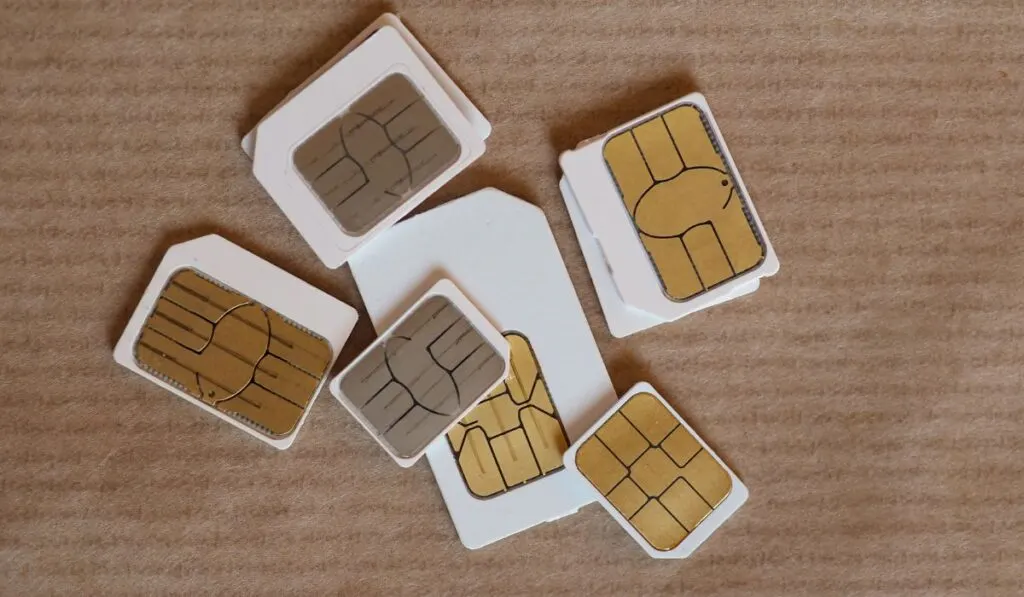If you’ve bought a new phone and your SIM card doesn’t fit into the SIM slot, it’s probably because your phone requires what’s known as a ‘nano SIM.’ But what exactly is a nano SIM, and how do you place it in your phone?
A nano SIM is the smallest type of SIM card. It fits in most of the latest smartphones and has the same functions as standard or micro SIMs — just with a smaller size. You can purchase a new nano SIM card, but typically your service provider will issue one and control the process of activating it.
Let’s take a detailed look at what information you can store on a SIM card, the differences between a nano SIM and other SIMs, and the proper way to add or remove a SIM card from your phone.
What Are SIM Cards, and What Do They Do?

A SIM card is a microchip that fits in your phone (or a similar device) and is used to identify the caller. Your SIM card contains information about your number, the carrier network, and the country in which you have access to make and receive calls on a local network.
SIM, which stands for subscriber identity module, stores data for GSM phones that are used worldwide.
You need a SIM card to access a unique number that’s registered with a cellular network in a specific country. The SIM card allows you to send and receive text messages and make calls with that unique number.
The SIM card also contains contact information and can save certain text messages, which can be accessed on any phone you put the SIM inside.
Without a SIM card, you’ll only be able to make calls and send messages via online apps, via access to WiFi. You can’t receive regular text messages and phone calls, and you won’t be able to use mobile data as you normally do.
What Is a Nano SIM Card?
A nano SIM card is a SIM card that’s smaller than the typical SIM cards. Nano SIM cards have less plastic around the chip and are used in newer smartphones such as the iPhone 11. The smaller size of a nano SIM card is beneficial in the latest phones since it leaves more space for internal components.
Nano SIM cards aren’t necessarily any different from regular SIMs in terms of functionality. In some nano SIM cards, however, the chip is designed with the latest technology, allowing you to store more information on the SIM.
That said, besides sometimes-better functionality and space-saving, there aren’t many differences between nano SIM cards and regular SIM cards.
If you’ve bought a new phone that requires a nano SIM card, you can have your existing SIM converted into a nano SIM through your network carrier. You can also purchase a new SIM, but you’ll have to change your number for that.
Fortunately, most SIM carriers will allow you to convert your existing SIM details to a new nano SIM without losing data. However, it’s best to update your contact information on the phone or on Google Contacts just in case.
Other Sim Card Sizes

Apart from nano SIM cards, there are standard SIMs, micro SIMs, and SIMs that are a combination of all 3, also known as combi SIMs. The main difference between these SIM cards is the size, and you can convert most SIMs into other types.
These are the alternatives to nano SIM cards:
Standard SIMs
Standard SIMs were introduced in 1996 and were used widely before the arrival of smartphones. These SIMs are larger than both nano and micro SIMs and are usually used in older phones. While they are still operational, they only fit in non-touchscreen phones and some older smartphones.
Micro SIMs
Micro SIMs aren’t as big as standard SIMs but have more plastic than nano SIMs. Most smartphones up to 2015 have space for a micro SIM, making this the most common type of SIM card. However, despite being used in modern phones, the only difference between micro and standard SIMs is the amount of plastic casing around the chip.
Combi SIMs
When you buy a new SIM, it usually comes in the form of a combi SIM. These SIMs have a plastic casing that can be broken, allowing you to convert them into standard, micro, or nano form.
While combi SIMs can be transformed into any type of SIM card, once you break the plastic casing, you won’t be able to make the SIM bigger again.
How to Place or Remove a SIM Card in a Phone
Adding or removing a SIM from your phone is a simple process, especially in the latest smartphones. Follow these steps to add or remove a SIM from your phone:
- Power off the phone.
- Look for the SIM card tray. In most smartphones, this is located on the side of the phone near the power or volume buttons. Some smartphones have a separate tray for SD cards and SIMs, so check that the tray fits a SIM card. In older phones, the SIM card may be located underneath the battery, and you’ll have to move the back cover to access it.
- Use a SIM tray removal pin (on Amazon) to remove the SIM card tray. You just need to push the pin into the hole on the side of the SIM tray, and the tray will pop out.
- Insert or remove the SIM card.
- Push the SIM tray back in the slot and power on the phone.
